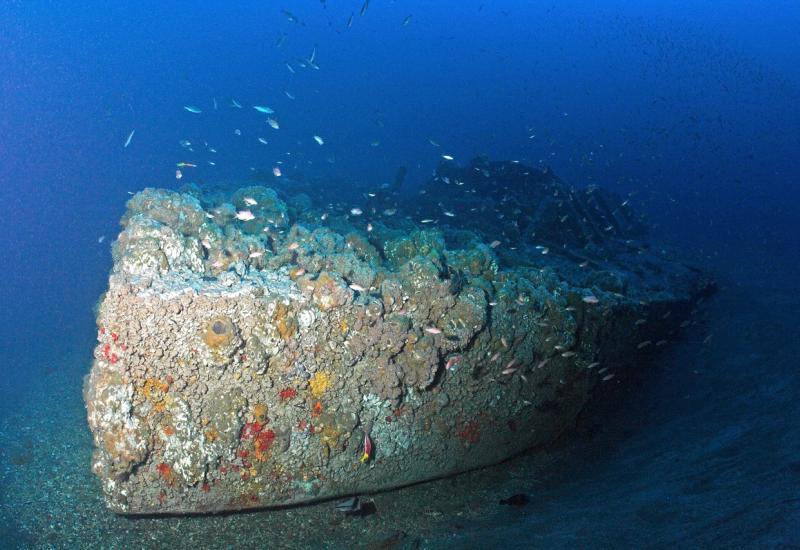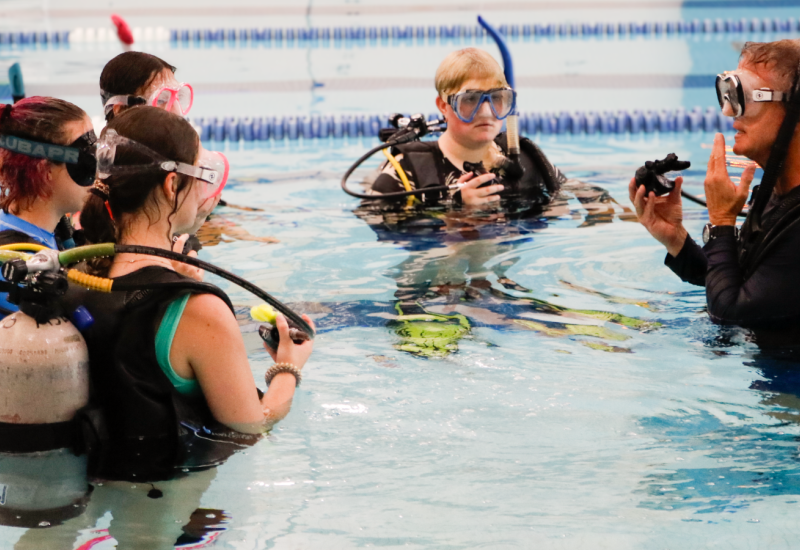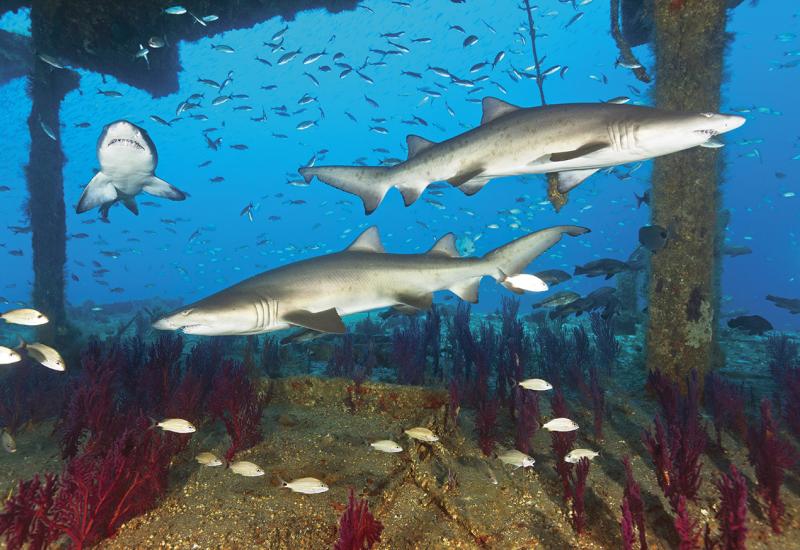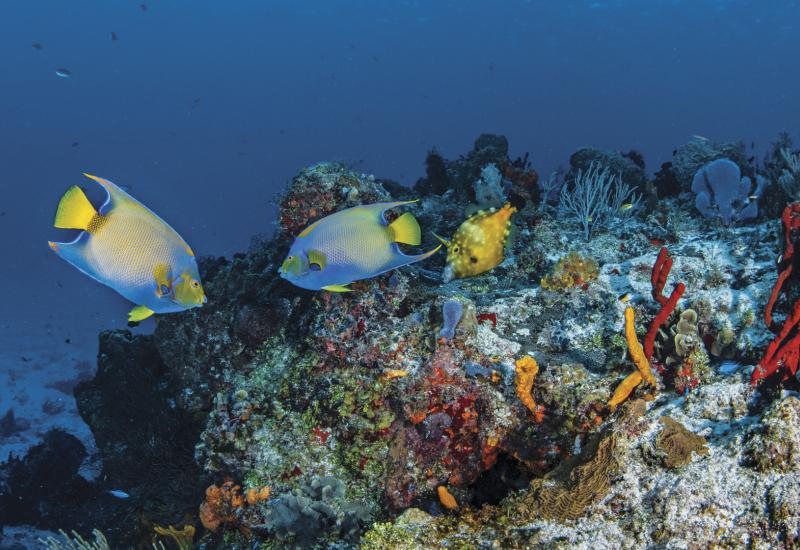Crystal Coast, N.C.

By Nick Lucey
Photo by Michael Patrick O'Neill
It's 6 a.m., and I'm killing time at Olympus Dive Center in Morehead City, N.C., waiting for the Midnight Express to whisk me to what is arguably the country's finest collection of diveable shipwrecks. For kicks, I count the tiny, boat-shaped icons on the shop's "Shipwrecks of North Carolina" map. I'm up to 200 and getting a splitting migraine when I decide to quit--and this is just the edition that includes the narrow swath of Atlantic from Cape Lookout to New River, covering only about a quarter of the area of the North Carolina coast where wrecks lie. The Tar Heel State's ocean floor bristles with thousands of ships and submarines that met their demise by running into sandy shoals or other boats, getting the business end of torpedoes and depth charges, or by being purposely sunk and designated as artificial reefs.
Finally, Midnight Express begins its two-hour journey to the most requested vessel in North Carolina's wreck portfolio--the German unterseeboot, or submarine, U-352. Our boat slices across Bogue Sound and out through Beaufort Inlet, and I daydream of diving new wrecks that lie undiscovered beneath our moving hull. As I don my wetsuit in anxious anticipation for the day's dives, I look around the deck and quickly realize this isn't your average recreational dive boat atmosphere; everyone else around me has techie accoutrements--backplates and wings, double 80s, rebreathers and even spearguns. I'm not in Cayman anymore, Toto. This collection of sunken ships, including the following trio, attracts wreck divers from up and down the East Coast. And if wreck diving is a religion, the U-352 is among its sacred temples.
U-352
She was one of about a dozen German subs that prowled America's eastern seaboard during World War II to pounce on Allied shipping networks, and entered service off North Carolina in April 1942. The U.S. had no prior experience with naval warfare near its shores, so it failed to impose blackouts on seaside communities. U-boats would use lights on shore to spot freighters by their moving silhouettes, and quickly dispatch them to the seafloor.
On May 9, 1942, after several frustrating weeks at sea without a single kill, Hellmut Rathke, the U-352's commander, spotted a freighter on the horizon he thought would be an easy target. He launched a single torpedo at the vessel but missed, and much to his chagrin, the freighter turned out to be the U.S. Coast Guard Cutter Icarus. The Icarus responded with a salvo of depth charges, crippling the U-boat and forcing it to surface. A deadly surface attack followed, with the Icarus crew killing 16 Germans and hauling off 33 more to internment camps. This would mark the first German U-boat sunk by a Coast Guard vessel during World War II.
This intense history grips me as I descend to the U-352, which now sits in 115 feet of water, more than 30 miles south of Morehead City, N.C. Much of the U-boat's 220-foot exterior hull has rusted away, leaving mainly its long, cylindrical pressure hull intact. The sub rests on her keel at a 45-degree list to starboard. The vis can be pretty good--as much as 100 feet on a good day--but this morning it's a greenish 30 feet, adding to its eerie atmosphere. I spot the typical cast of marine characters--grouper, small tropicals, clouds of baitfish and the now omnipresent lionfish.
The Spar
This ship was a U.S. Coast Guard Cutter built shortly after the U-352's sinking. The Spar is one of the area's newest wrecks, and arguably one of its fishiest. The 180-foot vessel was decommissioned in 1997 and sold at auction. The vessel was stripped of engines, generators and other equipment and was sunk in 2004 as an artificial reef. It lies next to the Aeolus, a cargo ship purposely sunk in 1988. The Spar lies in 110 feet of water, about 28 miles south of Morehead City, and is a crowd favorite for its scads of sand tiger sharks.
"You'll see sharks nearly 100 percent of the time on the Spar," says Bobby Purifoy, whose father George started Olympus Dive Center and was instrumental in discovering the U-352 and several other popular Crystal Coast wrecks. "They're also common on the Aeolus, Atlas, Caribsea and Papoose."
The Spar is a popular second dive after wrecks like the U-352, only a few miles away, after a long surface interval.
USS Schurz
This 295-foot ship was built in 1894 as the Imperial German Navy cruiser SMS Geier. The 255-foot Geier served Germany in the Pacific during World War I, when Japanese cruisers chased it into port at Honolulu. It was seized by the U.S. in 1914, refitted, and commissioned as the USS Schurz. Running without lights to avoid U-boats on June 21, 1918, the Schurz collided with the steamship SS Florida and sank to the 110-foot bottom. All but one crew member survived. Today, the wreck is home to huge clouds of baitfish, groupers, amberjacks and the occasional sand tiger and turtle.
I've dived some of the world's most prolific destinations, from Chuuk to the Turks & Caicos, but living within an eight-hour drive of North Carolina, I sometimes overlook things too close to home. I'm suddenly wracked with guilt for not diving these wrecks sooner, and now I know why many wrekkies, some of whom travel twice as far as I did to get here, find this place so special.
InDepth
Getting Around: Morehead City, at the heart of North Carolina's Crystal Coast, is about a 150-mile, three-hour drive from Raleigh, the state's capital. Head east-southeast on U.S. 70, via Goldsboro and New Bern. To get to Olympus Dive Center, at 713 Shepard St. in Morehead City, drive east on Hwy. 70 until you reach Morehead City. Once you arrive in Morehead, continue east on 70 past the Atlantic Beach Causeway Bridge. The side streets are numbered, decreasing from west to east. Turn right on 8th St., to 713 Shepard St.
Dive Conditions: Water temperatures range from the low 70s to low 80s from May through October, but can drop to the low 60s in winter. Visibility averages 50 to 70 feet, but can peak at 100 feet or more, especially during the summer when the Gulf Stream runs closer to shore. Spring and fall air temps range from the 60s to 70s, and can reach the 90s in summer. With wrecks so far from shore, be conservative with bottom times.
Dive Operators: Olympus Dive Center (olympusdiving.com). Other operators include Atlantis Charters (atlantischarters.net), Diver Down (diverdownscubadiving.com) and Sea Tails Charters (252-792-6542) in Atlantic Beach, Discovery Diving (discoverydiving.com) in Beaufort and Atlantic Beach Diving Services (atlanticbeachdiving.com) in Morehead City.
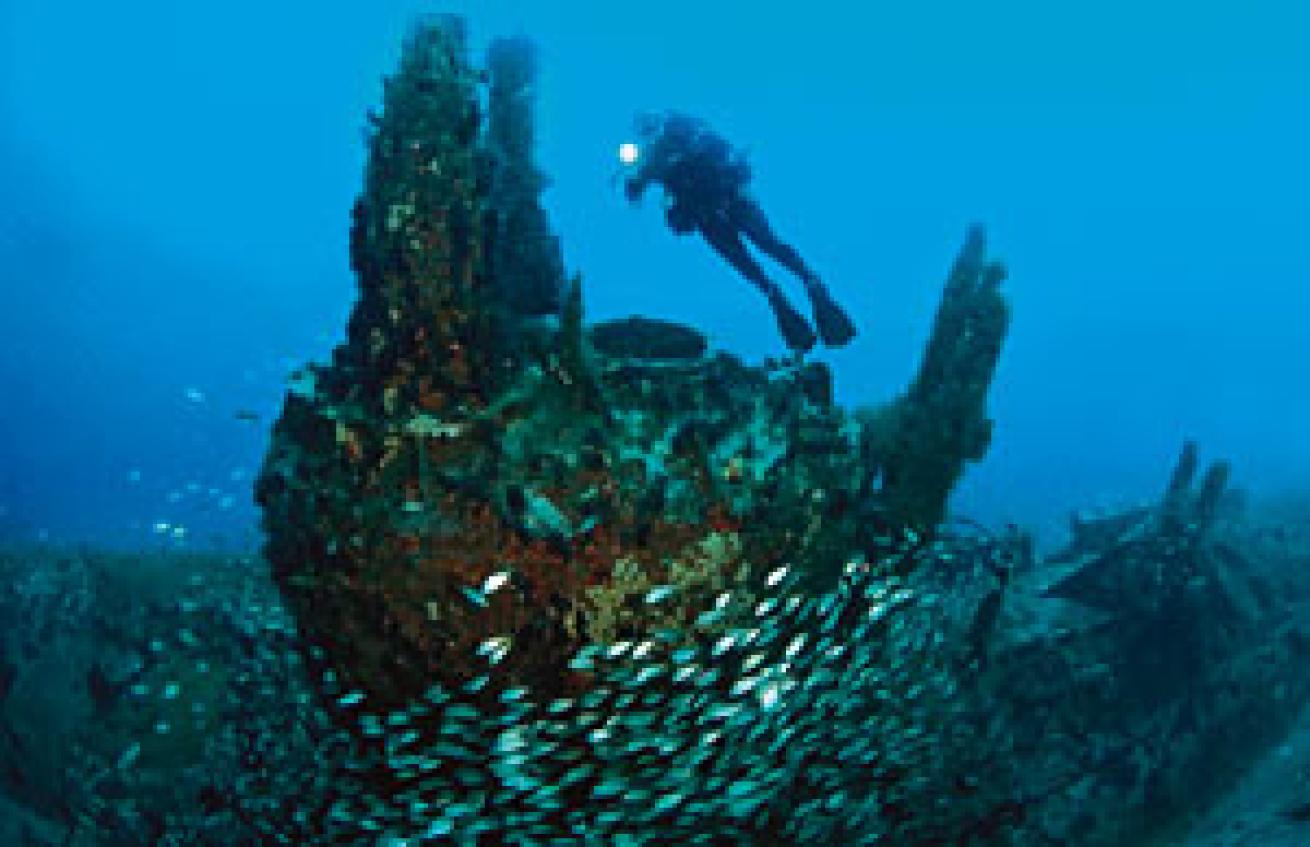
By Nick Lucey
Photo by Michael Patrick O'Neill
It's 6 a.m., and I'm killing time at Olympus Dive Center in Morehead City, N.C., waiting for the Midnight Express to whisk me to what is arguably the country's finest collection of diveable shipwrecks. For kicks, I count the tiny, boat-shaped icons on the shop's "Shipwrecks of North Carolina" map. I'm up to 200 and getting a splitting migraine when I decide to quit--and this is just the edition that includes the narrow swath of Atlantic from Cape Lookout to New River, covering only about a quarter of the area of the North Carolina coast where wrecks lie. The Tar Heel State's ocean floor bristles with thousands of ships and submarines that met their demise by running into sandy shoals or other boats, getting the business end of torpedoes and depth charges, or by being purposely sunk and designated as artificial reefs.
Finally, Midnight Express begins its two-hour journey to the most requested vessel in North Carolina's wreck portfolio--the German unterseeboot, or submarine, U-352. Our boat slices across Bogue Sound and out through Beaufort Inlet, and I daydream of diving new wrecks that lie undiscovered beneath our moving hull. As I don my wetsuit in anxious anticipation for the day's dives, I look around the deck and quickly realize this isn't your average recreational dive boat atmosphere; everyone else around me has techie accoutrements--backplates and wings, double 80s, rebreathers and even spearguns. I'm not in Cayman anymore, Toto. This collection of sunken ships, including the following trio, attracts wreck divers from up and down the East Coast. And if wreck diving is a religion, the U-352 is among its sacred temples.
U-352
She was one of about a dozen German subs that prowled America's eastern seaboard during World War II to pounce on Allied shipping networks, and entered service off North Carolina in April 1942. The U.S. had no prior experience with naval warfare near its shores, so it failed to impose blackouts on seaside communities. U-boats would use lights on shore to spot freighters by their moving silhouettes, and quickly dispatch them to the seafloor.
On May 9, 1942, after several frustrating weeks at sea without a single kill, Hellmut Rathke, the U-352's commander, spotted a freighter on the horizon he thought would be an easy target. He launched a single torpedo at the vessel but missed, and much to his chagrin, the freighter turned out to be the U.S. Coast Guard Cutter Icarus. The Icarus responded with a salvo of depth charges, crippling the U-boat and forcing it to surface. A deadly surface attack followed, with the Icarus crew killing 16 Germans and hauling off 33 more to internment camps. This would mark the first German U-boat sunk by a Coast Guard vessel during World War II.
This intense history grips me as I descend to the U-352, which now sits in 115 feet of water, more than 30 miles south of Morehead City, N.C. Much of the U-boat's 220-foot exterior hull has rusted away, leaving mainly its long, cylindrical pressure hull intact. The sub rests on her keel at a 45-degree list to starboard. The vis can be pretty good--as much as 100 feet on a good day--but this morning it's a greenish 30 feet, adding to its eerie atmosphere. I spot the typical cast of marine characters--grouper, small tropicals, clouds of baitfish and the now omnipresent lionfish.
The Spar
This ship was a U.S. Coast Guard Cutter built shortly after the U-352's sinking. The Spar is one of the area's newest wrecks, and arguably one of its fishiest. The 180-foot vessel was decommissioned in 1997 and sold at auction. The vessel was stripped of engines, generators and other equipment and was sunk in 2004 as an artificial reef. It lies next to the Aeolus, a cargo ship purposely sunk in 1988. The Spar lies in 110 feet of water, about 28 miles south of Morehead City, and is a crowd favorite for its scads of sand tiger sharks.
"You'll see sharks nearly 100 percent of the time on the Spar," says Bobby Purifoy, whose father George started Olympus Dive Center and was instrumental in discovering the U-352 and several other popular Crystal Coast wrecks. "They're also common on the Aeolus, Atlas, Caribsea and Papoose."
The Spar is a popular second dive after wrecks like the U-352, only a few miles away, after a long surface interval.
USS Schurz
This 295-foot ship was built in 1894 as the Imperial German Navy cruiser SMS Geier. The 255-foot Geier served Germany in the Pacific during World War I, when Japanese cruisers chased it into port at Honolulu. It was seized by the U.S. in 1914, refitted, and commissioned as the USS Schurz. Running without lights to avoid U-boats on June 21, 1918, the Schurz collided with the steamship SS Florida and sank to the 110-foot bottom. All but one crew member survived. Today, the wreck is home to huge clouds of baitfish, groupers, amberjacks and the occasional sand tiger and turtle.
I've dived some of the world's most prolific destinations, from Chuuk to the Turks & Caicos, but living within an eight-hour drive of North Carolina, I sometimes overlook things too close to home. I'm suddenly wracked with guilt for not diving these wrecks sooner, and now I know why many wrekkies, some of whom travel twice as far as I did to get here, find this place so special.
InDepth
Getting Around: Morehead City, at the heart of North Carolina's Crystal Coast, is about a 150-mile, three-hour drive from Raleigh, the state's capital. Head east-southeast on U.S. 70, via Goldsboro and New Bern. To get to Olympus Dive Center, at 713 Shepard St. in Morehead City, drive east on Hwy. 70 until you reach Morehead City. Once you arrive in Morehead, continue east on 70 past the Atlantic Beach Causeway Bridge. The side streets are numbered, decreasing from west to east. Turn right on 8th St., to 713 Shepard St.
Dive Conditions: Water temperatures range from the low 70s to low 80s from May through October, but can drop to the low 60s in winter. Visibility averages 50 to 70 feet, but can peak at 100 feet or more, especially during the summer when the Gulf Stream runs closer to shore. Spring and fall air temps range from the 60s to 70s, and can reach the 90s in summer. With wrecks so far from shore, be conservative with bottom times.
Dive Operators: Olympus Dive Center (olympusdiving.com). Other operators include Atlantis Charters (atlantischarters.net), Diver Down (diverdownscubadiving.com) and Sea Tails Charters (252-792-6542) in Atlantic Beach, Discovery Diving (discoverydiving.com) in Beaufort and Atlantic Beach Diving Services (atlanticbeachdiving.com) in Morehead City.

